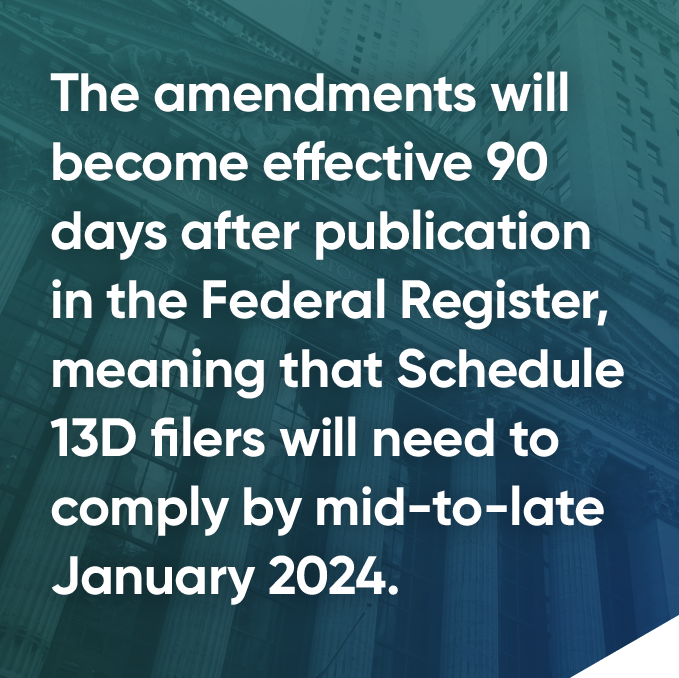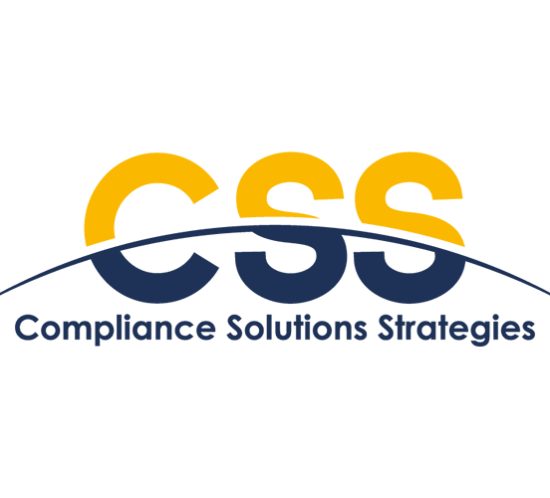SEC adopts Rule 13f-2 to increase transparency into Short-Selling
The SEC adopted new Rule 13f-2 to provide greater transparency into Short-Selling. Rule 13f-2 will require institutional investment managers that meet or exceed certain thresholds to report on Form SHO via EDGAR specified short position data and short activity data for equity securities. SEC will subsequently aggregate and publish certain data collected.
The filing thresholds for reporting issuers will be as follows: a monthly average of daily gross short positions of (i) $10 million or (ii) a monthly average position of 2.5% of issuer’s shares outstanding, and; for non-reporting issuers: $500,000 at the close of any settlement date during calendar month.
The deadline to submit the short-sale data will be 14 calendar days after each calendar month.
Rule 13f-2 and Form SHO will become effective 60 days following the date of publication of the adopting release in the Federal Register, while the compliance date for Rule 13f-2 and Form SHO will be 12 months after the effective date of the adopting release, with public aggregated reporting to follow 3 months later.
The Final Rule can be found at https://www.sec.gov/files/rules/final/2023/34-98738.pdf
How are investors impacted by the modernization of the Beneficial Ownership reporting in the US?
The modernization of the Beneficial Ownership reporting has been a long-discussed topic by the Securities and Exchange Commission (“SEC”) in the U.S. It therefore comes as no surprise that the adoption of amendments to Regulation 13D-G a few days ago is big news, as a large number of investors will have to comply with the updated rules.
But what is beneficial ownership reporting about? Pursuant to Regulation 13D-G and Exchange Act Sections 13(d) and 13(g), an investor who beneficially owns more than 5% of a covered class of equity securities is required to publicly file either a Schedule 13D or a Schedule 13G. Those investors with control intent file Schedule 13D, whilst those investors without a control intent, i.e., Qualified Institutional Investors (QIIs) and Passive Investors, as well as Exempt Investors, file Schedule 13G.
Accelerated filing deadlines will increase costs
SEC Chair, Gary Gensler, highlights the fact that the rules governing beneficial ownership reporting haven’t been amended for half a century, and hence, it is imperative that the filing deadlines are shortened. Such an approach is consistent with the need to reduce information asymmetries in today’s financial markets, as material information will be spread in a more timely manner. At the other end of the scale, by accelerating the filing deadlines for Schedules 13D and 13G, smaller investors will have to pay the price for speedier filings.
The deadlines will be shortened for both initial and amended Schedule 13D-G filings. More specifically:
- The deadline for initial Schedule 13D filings is shortened to five (5) business days, while Schedule 13D amendments will have to be filed within two (2) business days;
- For QIIs and Exempt Investors, the initial Schedule 13G filing deadline is set as 45 days after the end of the calendar quarter in which beneficial ownership exceeds 5% of the covered class;
- For Passive Investors, the initial Schedule 13G filing deadline is set as five (5) business days;
- All Schedule 13G filers are required to file an amendment 45 days after the calendar quarter in which a material change occurred and;
- Schedule 13G amendment obligations for QIIs and Passive Investors are accelerated when their beneficial ownership exceeds 10% or increases or decreases by 5%.
Plus, the filing “cut-off” time is extended to 10 p.m. Eastern time, as a counterweight to the new shortened deadlines.
Disclosure of certain cash-settled derivatives provides clarity as to the calculation requirements
Next to the adopting release, SEC also issued guidance which sheds light on the inclusion of certain cash-settled derivatives, as Schedule 13D disclosure requirements needed clarification in this respect. This practically means that the scope of the beneficial ownership reporting rules is broadened for the sake of transparency. Now, Schedule 13D filers are required to disclose interests in all derivative securities – including cash-settled derivative securities – that use the issuer’s equity security as a reference security. Despite this, opposing voices are raised with regard to the ambiguity of the framework provided[1] which could very well result in incorrect filings.
The term “group” is further analyzed together with its related exemptions
The circumstances under which two (2) or more persons have formed a “group” that would be bound by the obligations arising from the beneficial ownership reporting are also discussed in the guidance. Investors need to be aware of the criteria determining the group formation and for that reason, clarification is given. The mere presence of an express agreement between two or more persons is not the sole factor that suffice for the formation of a group, as concerted actions are required, too, for the purpose of acquiring, holding, or disposing of securities of an issuer. Again, certain questions have been left unanswered, the main one being the importance (or not) of an “express agreement” in the group formation, as it is important for filers not to miss a filing.
The use of a structured, machine-readable data language for Schedule 13D and 13G means additional effort for filers
Schedule 13D and 13G filers would have to devote additional effort to prepare the final report for submission, given that a structured, machine-readable data language will now be required. Under this structured data requirement, only the exhibits to Schedules 13D and 13G will remain unstructured. The use of an XML-based language implies the necessity to gain expertise in preparing these submissions. Third-party vendors equipped with professionally trained staff can be of great assistance to investors in this regard. Nevertheless, from the standpoint of the Commission, all the information received is expected to be analyzed in a smoother manner due to the homogeneity of the data language.
When are investors expected to comply with the amendments?
The amendments will become effective 90 days after publication in the Federal Register, meaning that Schedule 13D filers will need to comply by mid-to-late January 2024. Compliance with the revised Schedule 13G filing deadlines will be required beginning on September 30, 2024. For instance, a Schedule 13G filer will be required to file an amendment within 45 days after September 30, 2024, if, as of end of the day on that date, there were any material changes in the information the filer previously reported on Schedule 13G. Compliance with the structured, machine-readable data requirement for Schedules 13D and 13G will be required on December 18, 2024.
The amendments will become effective 90 days after publication in the Federal Register, meaning that Schedule 13D filers will need to comply by mid-to-late January 2024. Compliance with the revised Schedule 13G filing deadlines will be required beginning on September 30, 2024. For instance, a Schedule 13G filer will be required to file an amendment within 45 days after September 30, 2024, if, as of end of the day on that date, there were any material changes in the information the filer previously reported on Schedule 13G. Compliance with the structured, machine-readable data requirement for Schedules 13D and 13G will be required on December 18, 2024.

However, early compliance with this requirement is welcome, and Schedule 13D and 13G filers may begin to voluntarily comply with the structured data requirement on December 18, 2023.
Check out this short video on Beneficial Ownership and 13GAll in all, these developments seem to modernize the beneficial ownership regime in the US, but, at the same time, add to the complexity of the daily work conducted by in-house compliance teams. Third-party vendors, like Confluence, can assist with the preparation of correct and timely filings with their experienced professionals, as they are closely monitoring regulatory amendments and are well-prepared in advance. Missed, incorrect or late filings can cost investors a great deal of money, but third-party vendors can help them avoid those significant fines imposed by the SEC.
Contact Us HereTakeaways from the SEC’s New Private Fund Adviser Rules – Build and Plan for Successful Implementation
The private fund regulatory landscape just got more complex with the August 23 SEC adoption of these long-awaited private fund rules, which were first proposed 18 months ago in the face of industry pushback. These rules align with the agenda by SEC Chairman Gary Gensler, who has been steadfast in his commitment to enacting a proposed rule. The rules address the risks and harm to investors and funds identified by the SEC, such as conflicts of interest, lack of transparency, and lack of governance mechanisms.
Notably, although included in the initial rule proposal, no changes were made to private fund liability rules, which would have made it much easier for LPs to sue GPs
With the final rules enacted and a long and varied runway of compliance dates, now is the critical time for Advisers to prepare, build and implement a plan for successful compliance implementation.
9 Key Takeaways from These New Rules:
| Rule Number: | Topic: | Takeaway: |
|---|---|---|
| 1. Amended Rule 206(4)-7 | Written Annual Compliance Review (All SEC Registered Advisers) | All SEC advisers, not just those to private funds, are required to document in writing the Annual Review of their compliance policies and procedures. |
| 2. New Rule 211(h)(1)-2 | Private Fund Quarterly Statements (SEC Registered Private Fund Advisers) | The rule requires SEC registered private fund advisers to distribute a quarterly statement to investors in the funds, including information in “table form” on fees and expenses, performance, adviser compensation, all portfolio investment compensation, and fee and performance calculation methodology details to ensure transparency. |
| 3. New Rule 211(h)(2)-2 | Adviser – Led Secondaries Fairness or Valuation Opinion (SEC Registered Private Fund Advisers) | Regarding adviser-led secondaries, it will require that the advisers must obtain and distribute to investors an independent fairness or valuation opinion. The above is required when offering existing fund investors the option between selling their ownership interests in a private fund and converting or exchanging their interests in the private fund for interests in another investment vehicle advised by the adviser or any of its related persons. In addition, the adviser must prepare and distribute to investors a summary of any material business relationships over the past two years between the adviser, its related persons and the opinion provider. |
| 4. New Rule 211(h)(2)-3 | Preferential Treatment (For All Private Fund Advisers) | Private fund advisers are prohibited from providing preferential terms to investors regarding a) certain redemptions from the fund unless the investors have the ability to redeem because it is required by applicable law or the adviser offers the preferential redemption rights to all other investors without qualification; and b) certain preferential information concerning portfolio holdings or exposures, unless such preferential information is offered to all investors. In addition, private fund advisers cannot provide preferential treatment to investors unless certain terms are disclosed in advance of an investor’s investment in the private fund and all terms are disclosed after the investor’s investment. |
| 5. New Rule 211(h)(2)-3 | Restricted Activities (For All Private Fund Advisers) | Prohibits an adviser from charging to the fund fees and expenses related to investigations that result in a court or government authority sanctioning the adviser for violating the Advisers Act.
Restrictions on charging fees or expenses associated with an investigation of the adviser without disclosure and consent from fund investors (such expenses cannot be charged where a sanction is imposed). Prohibits charging regulatory, examination or compliance fees unless detailed notice to investors is provided. Prohibits charging fees related to a portfolio investment on a non-pro-rata basis unless the allocation approach is fair and equitable with advance written notice and description details. There are also additional restrictions on reducing the amount of an adviser clawback by the amount of certain taxes unless written notice of both pre-tax and post-tax amounts is provided. Prohibited from borrowing or receiving an extension of credit from private funds without written notice and consent from a majority of unrelated investors. |
| 7. New Rule 206(4)-10 | Private Fund Audits (SEC-Registered Advisers) | Annual fund financial statement audits by an independent public accountant are required for all private funds. The new requirements account for strengthened annual audit requirements to ensure greater transparency and must meet the audit requirements of Advisers Act Rule 206(4)-2). |
| 8. Amended Rule 204-2 | Recordkeeping Rule (For SEC Registered Advisers) | There are recordkeeping requirements for Quarterly Statements, the Audit Rule, Adviser-Led Secondaries, Restricted Activities, Preferential Treatment, and the Annual Review. |
| 9. Adviser Misconduct | Existing Fiduciary and Anti-Fraud Provisions | While the SEC did not adopt a rule, the SEC stated in the Adopting Release that charging fees without providing a service to a private fund client is inconsistent with the adviser’s fiduciary duty. In addition, an adviser is not permitted to charge for services that it does not reasonably expect to provide. Similarly, while not adopting a rule, the SEC stated in the Adopting Release that the fiduciary duty and antifraud provisions apply to limiting or eliminating liability, as discussed in detail in the Adopting Release. |
Please refer to the SEC Related Materials for complete information.
Key Compliance Dates:
| Rule Number: | Compliance date – (After Federal Register publication date): | Type of Adviser: |
|---|---|---|
| Amended Rule 204-2 – Record Keeping | 12 months (>$1.5 Billion in PF assets) – 18 months (<$1.5 Billion in PF assets) | SEC-Registered Private Fund Advisers |
| Amended Rule 206(4)-7 Written Annual Compliance Review | 60 days | For All SEC Registered Advisers |
| New Rule 206(4)-10 Private Fund Audits | 18 months | SEC-Private Fund Registered Advisers |
| New Rule 211(h)(1)-2 Private Fund Quarterly Statements | 18 months | SEC-Registered Private Fund Advisers |
| New Rule 211(h)(2)-1 Private Fund Adviser Restricted Activities | 12 months (>$1.5 Billion) – 18 months (<$1.5 Billion) | For All Private Fund Advisers |
| New Rule 211(h)(2)-2 Adviser-Led Secondaries | 12 months (>$1.5 Billion) – 18 months (<$1.5 Billion) | SEC-Private Fund Registered Advisers |
| New Rule 211(h)(2)-3 Preferential Treatment | 12 months (>$1.5 Billion) – 18 months (<$1.5 Billion) | For All Private Fund Advisers |
Conclusion: Time to Buckle up with Foresight and Planning
As the regulatory landscape continues to shift, it is imperative for advisers to be proactive and adapt to the changing environment to best serve fund investors. The SEC’s Private Funds Rules have expanded the regulation of private fund advisers.
Private Fund Advisers must build and plan for successful implementation by the Compliance Dates. This takes careful planning and consultation with experts and counsel. It is imperative that firms begin this process now.
Planning includes items such as:

- Evaluating the rule’s impact,
- Updating policies and procedures,
- Planning processes for distribution and consents,
- Planning for recordkeeping changes,
- Conducting Annual Fund Audit,
- Developing disclosures,
- Planning processes, content and disclosures related to Statement distribution,
- Revisiting fund fees and expenses,
- Reviewing side letter terms, among other measures,
- Operational changes,
- Planning and Conducting testing,
- Conducting Training,
- Documenting the Annual Review in writing,
- Among Others
Although the compliance period varies among managers, as noted above, we are likely to see a significant impact on future SEC examinations and enforcement activities.
Advisers need to prepare for change with the new regulations as emphasized by Chair Gensler’s analogy to the evolution of the boxing champion from Rocky to Creed during the August 23 meeting (U.S. Securities and Exchange Commission, 2023)
To learn more about how to prepare for implementation of the Private Fund Rule and to learn more about Confluence’s Compliance Services and regulatory reporting solutions, contact us at info@confluence.com
Contact Us HereDisclaimer: The information contained in this communication is for informational purposes only. The opinions expressed herein are those of the author and do not necessarily reflect those of Confluence. Confluence is not providing legal, financial, accounting, compliance, or other similar services or advice through this communication. Recipients of this communication are responsible for understanding the regulatory and legal requirements applicable to their business.
SEC adopts amendments to modernize Beneficial Ownership reporting (Regulation 13D-G)
The SEC adopted rule amendments governing beneficial ownership reporting under Sections 13(d) and 13(g) of the Securities Exchange Act of 1934. The key amendments are as follows:
• shortening of the deadlines for initial and amended 13D and 13G fillings – there are different deadlines based on the type of investor. New filing “cut-off” time will be 10:00 p.m. Eastern time;
• clarification on the criteria for group disclosures;
• use of a structured, machine-readable data language for filings.
As Schedule 13D and Schedule 13G haven’t been updated for nearly half a century, the SEC Chair’s statement that “it shouldn’t take 10 days for the public to learn about an attempt to change or influence control of a public company” gives emphasis on the Commission’s endeavors to improve transparency and provide more timely information for shareholders and the market.
The amendments will become effective 90 days after publication in the Federal Register. Compliance with the revised Schedule 13G filing deadlines will be required beginning on September 30, 2024. Compliance with the structured data requirement for Schedules 13D and 13G will be required on December 18, 2024.
The Final Rule and the Guidance can be found at https://www.sec.gov/files/rules/final/2023/33-11253.pdf
In the News Post: Three Trends for 2024: Unstructured Data versus Rising Regulation
Predictions on the Asset Management Industry for 2024
Driven by the SEC’s busy agenda and economic headwinds such as bank failures, 2023 is proving to be another turbulent year. The newTailored Shareholder Report rule, Form PF changes, changes to the SEC’s private fund rules and the SEC’s climate disclosure proposal are all underway, set to have major impact.
Simultaneously, AI is transforming how asset management firms operate and comply with regulations, new and old.
Disruptions such as rapid consolidations, especially among mid-tier active managers, are adding to market dynamics. And with assets under management declining at the fastest rate in 15 years, investment firms are recognizing the benefit of partnering with fewer and larger vendors. Technology providers with complementary capabilities are consolidating, leading to heightened cost pressure as M&A activity becomes a one-stop-shop for solutions and services.
All that said, heading into 2024, here are the three trends we predict will have the most impact on our industry.
Prediction 1: As rising regulation clashes with unstructured data, AI may be the sole solution
Regulatory authorities embrace digital solutions. Several recent examples, such as TSR and iXBRL, reveal that investor and regulatory documents are becoming one and the same, ramping up the pressure on firms to have the right data and systems to deliver greater transparency.
At the same time, new technology, particularly in AI and large language models, is making it easier than ever to automate the gathering, analyzing and submitting of regulatory reports. Several institutions are known to use AI and machine learning in various capacities; as just one example, State Street is developing investment models and strategies using AI and applying it in ESG investing.
Here’s the caveat. While AI has led to productivity and efficiency gains, most applications have been powered by structured data. That’s a severe constraint. But pairing generative AI with LLM (Large Language Models) has unlocked AI to work with unstructured data, a sea change.So while we’ll see many applications of GenAI/LLMs across all industries and domains, Investor communications and regulatory reporting have a particularly high level of unstructured data. This creates an above-average opportunity for GenAI/LLM pairing to improve efficiency and client experience. Watch for it.
Prediction 2: Firms with alternative and/or proprietary data will reap the benefits
Demands for greater data access and transparency will only intensify. Regulators may even open consultations into data access and rights.Efficiently handling large volumes of granular data is no longer optional; it is necessary for identifiers such as CUSIPs that enable data integrity within financial systems.
ESG ratings are a prime example of the effects of data regulation. With increased emphasis on ESG data to assess companies’ sustainability and ethical practices, we expect to see more firms invest in robust data systems to meet new analysis and reporting standards.
Exchanges will continue to play a crucial role in providing financial data, including market prices and trading volume. But given exchanges’ significant control over access to and pricing of this data, asset managers will be seeking alternative data sources.
Net net? Firms that have proprietary and unique data sets, and are able to leverage them, will have a significant advantage over those that don’t. In 2024, we will see more asset managers use and reuse data across the business.
Prediction 3: Heightened scrutiny will force private assets to manage risk like public funds
Recent regulatory reforms signal the increased importance the SEC places on risk management. Investors are continuing to demand better risk assessments of their private investments. That, in turn, puts pressure on managers of private assets to provide the heightened level of transparency appropriate for inclusion in an overall risk management program.
Appropriate asset allocation strategies, monitoring, and thorough due diligence to address diverse types of risks will continue to remain top of mind for asset managers. The SEC recently adopted its much anticipated updates to the private fund rules in late August. These reforms include a new quarterly reporting requirement covering performance, fees and expenses of private funds increasing the transparency of these products to end investors.
While less earth-shattering than expected, this increased scrutiny from the SEC portends similar changes to other alternative regimes. We anticipate even further regulatory reforms, possibly involving revisions to regulations such as UCITS/AIFMD, further money market fund reform, and liquidity/risk reporting.
In conclusion
To address the challenges inherent in rising regulation meeting unstructured data, the asset management industry will be embracing AI-driven technologies in 2024. Firms with proprietary and unique data will have a significant advantage over those that don’t. In addition, risk management will emerge as a central focus in private asset management.
Behind the Curtain – SEC’s Risk-Based Approach to Examinations
The SEC Division of Examinations (“EXAMS”) issued a Risk Alert describing EXAMS’ risk-based approach for selecting registered investment advisers to examine and determining the scope of examinations. The Risk Alert included an example of a typical initial request for documents and information, as well as examples of additional information that EXAMS may request during the examination process. The Alert identified three (3) components used to assess an adviser’s risks and scoping examinations:
- Selecting firms to examine;
- Selecting examination focus areas; and
- Selecting documents to request.
Selecting Firms to Examine
Given the size and variety of the adviser population, EXAMS utilizes a dynamic risk-based approach for selecting advisers to examine and determining the scope of the examination. EXAMS’ approach is designed to adapt to changes in markets conditions, industry practice, and investor preferences. An adviser may be selected for an examination to evaluate the risks present at a particular firm, to respond to events that pose risks to investors and markets, or to evaluate how registrants are responding to new regulatory requirements. Roughly 15% of the more than 15,000 registered advisers are examined in any particular year.
EXAMS selects advisers for examinations for a variety of reasons. The reasons include firm-specific risk factors and/or factors such as a tip, complaint, or referral, or the staff’s interest in a particular compliance risk area. The annual priorities published by EXAMS provide a guide for understanding the topics on which EXAMS may focus.
With respect to specific risk factors, EXAMS uses data analytics to identify an adviser’s products and services and assess the associated risk. EXAMS considers firm-specific risk factors based on a particular adviser’s business activities, conflicts of interest, and regulatory history. For example, consideration may be given to prior examination observations such as repetitive deficient practices or other significant compliance program concerns, the length of time since registration or an adviser’s last exam, or media reports that either involve or impact a firm.
Selecting Examination Focus Areas
After an adviser is selected for examination, EXAMS evaluates risk factors to determine the scope of the examination. Reviews of an adviser’s compliance program generally include a review of the adviser’s operations, disclosures, conflicts of interest, and compliance practices with respect to core areas including custody and safekeeping of client assets, marketing and advertising, valuation, portfolio management, fees and expenses, as well as brokerage and best execution.
Selecting Documents to Request
An examination typically begins with a letter from EXAMS notifying an adviser of the exam and a request to produce documents. The scope of the information requested varies depending on the focus areas of the examination. The Risk Alert included an attachment with the staff’s typical initial request for documents and information. That attachment and the full risk alert can be found at the link below:
Takeaways from the Risk Alert
EXAMS has provided an overview of their process for selecting advisers for examinations. Advisers should use this information to be prepared for an examination. Preparations start by identifying the risk associated with a firm’s advisory business and product offerings and conflicts of interest. Such risks and conflicts need to be incorporated into a firm’s written compliance policies along with policies designed to address regulatory requirements.

The next step is to test and evaluate your policies and their effectiveness. Testing is also a means of determining whether a firm is retaining required records and they are accessible for production when requested.
The final step is education. Share the information discussed in the Risk Alert with management teams and supervised persons so that the firm is prepared for a regulatory examination.
To learn more about the examination process, industry practices, and how to prepare, please use the link below:
Book a Strategy Call







